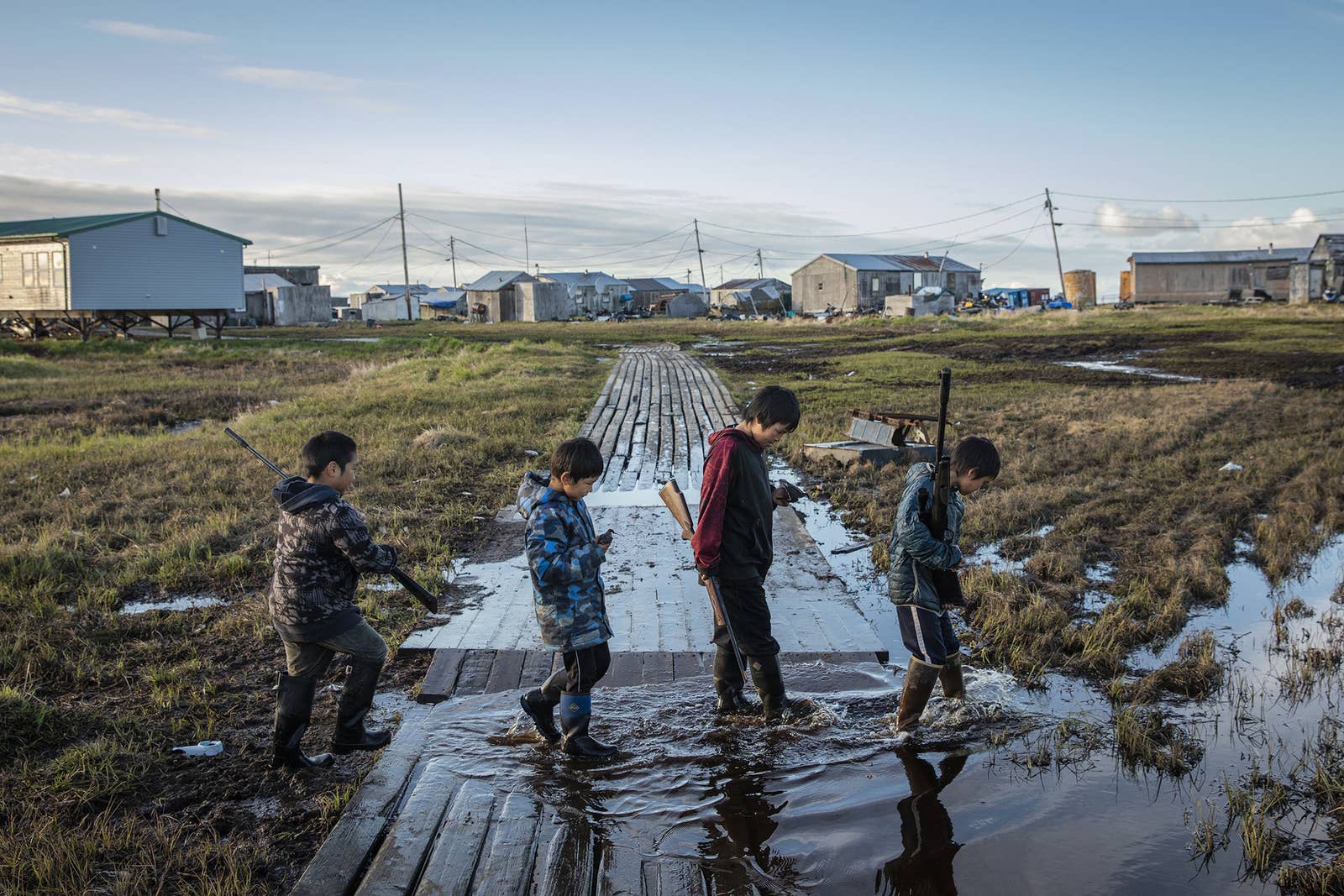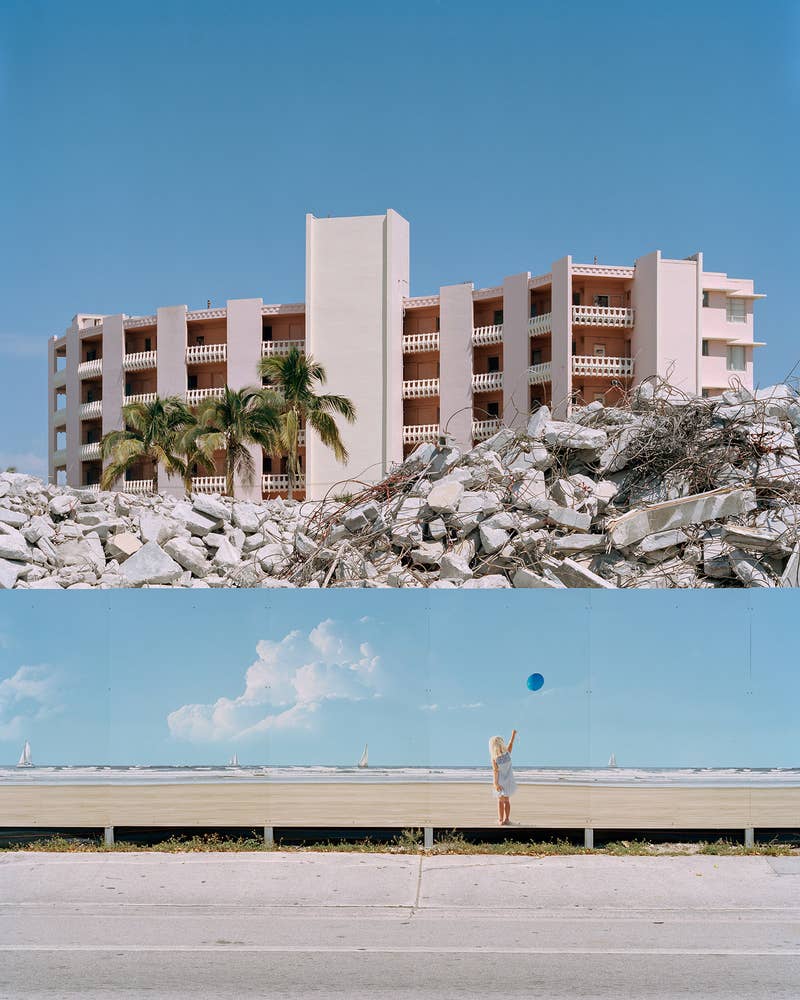A New Exhibition Captures The Stark Reality Of Climate Change
"Just like COVID, the climate crisis can almost feel invisible at times and is hard to understand unless you are directly affected — and even then there are people who don’t seem to grasp the reality of it."
Gabriel H. SanchezSenior Photo Essay Editor
Posted on July 28, 2020


Katie Orlinsky
On a summer bird hunt, Kenyon Kassaiuli, Jonah Andy, Larry Charles, and Reese John cross a flooded walkway in Newtok, Alaska, May 27, 2019. The Yupik village of Newtok, Alaska, is sinking as the permafrost beneath it thaws and the land erodes. It is estimated that in three to five years it could be underwater. Newtok is the first community in Alaska to have already begun relocation as a direct result of climate change — pioneering a process that many other Alaskan villages may soon undergo.
The United Nations has described the looming threat of climate change as the "defining crisis of our time." Today, as much of the world grapples with the health and economic fallout from the coronavirus pandemic, the stark reality of a global catastrophe is perhaps more real than ever before.
A new online exhibition at the Bronx Documentary Center explores some of the immediate effects of climate change in the US by piecing together a web of information about how the current administration is failing to address this troubling reality. The show is part of an ongoing series of programming called Trump Revolution, which chronicles the impact of Trump's policies on global affairs. While the exhibition was originally scheduled to be staged at the center's Bronx galleries, the coronavirus pandemic has forced the show to be adapted for the web.
Here, exhibition coordinator Cynthia Rivera shares with BuzzFeed News the work of six photojournalists featured in the exhibition and her thoughts on how the current COVID-19 crisis can foreshadow the more severe effects of climate change.
Can you talk a bit about the concept behind the Trump Revolution exhibition series?
The idea began when Donald Trump first started campaigning. When he took office, things started to happen very quickly in terms of policy changes and I think a lot of us were still processing the election. To help take account of all of these things, we decided to develop exhibition programming that would use photography to figure out if there was some kind of through line or theme in terms of what we felt like the president was targeting.
Immigration was the topic of our first exhibition and was developed at a time when ICE raids were at the forefront of the news. Next we chose to focus on the climate crisis at time when Trump decided to pull out of the Paris agreement. As the news cycle shifts from week to week, we thought it would be important to bring these topics back in focus and show that these things are still happening, whether we see them in the news or not.

Stacy Kranitz
The massive Exxon chemical plant is next to the ExxonMobil refinery in the Standard Heights neighborhood of Baton Rouge, Louisiana, in April 2017. ExxonMobil Chemical Company has been caught regularly releasing air pollution above what is lawfully allowed in its permit.
Who are some of the photographers you featured in Trump Revolution: Climate Crisis?
For this chapter, we wanted to focus our scope on how the climate crisis was specifically affecting the US. We approached the topic of sea level rising through the work of Bryan Thomas in Florida, as well as through the work of Katie Orlinsky on how Indigenous people in Alaska are being affected. We discuss the devastation caused by wildfires in California through the work of Marcus Yam and discuss pollution in both the air and water with the work of Stacy Kranitz. Lastly, projects by Yuri Kozyrev and Kadir van Lohuizen, partly in Alaska and partly in Russia, chronicle the overall effect of what was happening in the north and how it affects the rest of the world in terms of sea level rising and climate change.
These five key points visually cover in a beautiful and tragic way what’s actually happening. We so often discuss the climate crisis in an abstract manner that can be hard to understand. So we wanted to show the actual people that climate change is affecting and what it actually looks like.
How has the coronavirus pandemic affected this exhibition?
We were able to adapt the exhibition into a digital format fairly quickly. My goal was to develop a website that mirrored the way a visitor would move through our physical space.
At the top of our exhibition page is our timeline, which would have been displayed around the entire top of our gallery space, and from there you go to the individual artist pages that are sequenced in the way they would have been seen in the gallery. One unique challenge of adapting the exhibition for online is keeping the energy alive enough to ensure that visitors won’t want to leave the page. It’s so much information to digest, so my challenge was to approach this quickly, but not so quickly that you miss too many things.
Our last page is the environmental solution and action page. For us, we felt like the show needed a space to show what people can do about all of the terrible things they just digested. These are things that you can personally do so that you don’t feel frozen in these circumstances — this is hope.

Bryan Thomas
Construction begins on the Auberge Beach Residences and Spa in Lauderdale-by-the-Sea, Florida. The streets of nearby Fort Lauderdale regularly flood during “king tides.” According to Climate Central researcher Benjamin Strauss, “Even if we could just stop global emissions tomorrow on a dime, Fort Lauderdale, Miami Gardens, and Hoboken, New Jersey, will be under sea level.”

Stacy Kranitz
Louisiana, September 2017. Southern University offers beautiful views of the Mississippi River, but it is located next to the Devil’s Swamp Superfund site and surrounded by petrochemical plants and toxic waste sites. A slew of leaks, discharges, and accidents have impacted Southern University, including toxic leaking railroad tank cars, ruptured pipelines, chemical spills from tank trucks, and leaking barges on the river, making it the country's most adversely impacted institution of higher learning.
From your perspective, how does the current COVID-19 crisis reflect the reality of the climate crisis?
I feel like in both cases there are groups and types of people who pay attention to things like this, but there are also a lot of people who don’t. It’s pretty evident that this country is split in terms of people who actually understand what is happening, which is crazy.
Just like COVID, the climate crisis can almost feel invisible at times and is hard to understand unless you are directly affected — and even then there are people who don’t seem to grasp the reality of it.
What do you hope people will get from the exhibition?
I would hope that within all of the information that we gathered and connected, people will better understand the connection between the word and the idea of the climate crisis. It’s my hope that in highlighting the people being affected by the crisis today ... that they would see themselves within these pictures. That’s always my hope — to help people to empathize.

Katie Orlinsky
After a successful hunt, Josiah Olemaun, a young whaling crew member, takes a break from moving and stacking whale meat into his family’s ice cellar in Utqiagvik, Alaska, April 29, 2018. Ice cellars are generations-old massive underground freezers dug deep into the permafrost. As permafrost thaws, it is wreaking havoc, melting what used to be permanently frozen ground and destroying and flooding many ice cellars. Others have warmed up to a point that they are unusable, spoiling whale meat and other crucial hunted foods.

Marcus Yam / Los Angeles Times
Smoke from the Maria fire billows above Santa Paula, California, Oct. 31, 2019. The state’s largest utility, Pacific Gas & Electric Co., initiated multiple rounds of power shutoffs that plunged nearly 2.5 million people into darkness throughout Northern and Central California.

Marcus Yam / Los Angeles Times
A 16-year-old resident of Island View Drive wipes her tears in Ventura, California, Dec. 5, 2017; her family's home was destroyed by the Thomas fire.

Yuri Kozyrev / NOOR for Fondation Carmignac
The copper factory in Norilsk, Russia, in August 2018. Three plants of Norilsk — the nickel factory, the copper factory, and the metallurgical complex — were built successively in 1942, 1949, and 1981. Fifty-six percent of the city's population works in these places.

Bryan Thomas
From left: Esmeralda Garcia, Kali Cedeno, and Anthony Cedeno stand in the ocean in Destin, Florida. Given the current trends in pollution, 50% of the city of Destin will be underwater by the year 2070.
Kadir Van Lohuizen / NOOR for Fondation Carmignac
Whale hunting in Point Hope, Alaska, May 2018. The Inuit community of Point Hope is allowed to catch 10 bowhead whales per year. Due to the early disappearance of the sea ice, it’s much harder for the community to catch whales.

TOPICS IN THIS ARTICLE
Climate Change

Gabriel H. Sanchez is the Senior Photo Essay Editor for BuzzFeed News and is based in New York City.
No comments:
Post a Comment